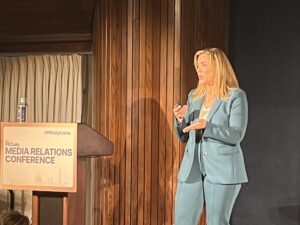PR pros reveal their very favorite measurement
Because yes, you’ve gotta do math.

Measuring PR impact is one of the most difficult yet most important parts of the practice. Communicators must be able to show how their work impacted broader business goals, but because PR works in subtle, sometimes mysterious ways, it can be difficult to draw straight lines. But measure we must, and as technology improves, there are more ways than ever to measure PR.
I asked a simple question on LinkedIn: “Nerds only: What is your favorite way of measuring PR impact?”
Obviously, there is no one right way. It all depends on what you’re trying to accomplish. But the question yielded dozens of responses from PR pros from a variety of disciplines, many approaching it in very different ways.
Here’s a sampling of some of their answers. I’d love to hear yours in the comments.
Responses have been lightly edited for style, clarity and brevity.
Lynnea Olivarez, founder and community manager, Ticket to Biotech
While quantitative metrics are critical, qualitative analysis is underrated and also imperative to tell the whole story.
A few philosophical examples:
- Should a NYT A1 mention be weighted the same as a trade publication feature?
- What about a CEO who comments that more employees are saying hi to her in the hallway and just “seem happier”? Yes, we hope we could back that up (or in some cases, disprove it!) with an engagement survey, but I’d argue that there’s tremendous validation in your CEO’s belief that your comms or corp affairs function had something to do with that.
- Or in my industry (biopharma), patient community relationships are incredibly important. If the leading organization in one’s target area publicly gushes about your company, that’s uber valuable but how do you put a numeric value on it?
Mike Nachshen, president and owner, Fortis Communications
In the B2G space, where the sales cycle can take months, if not years, measurement nirvana is when you learn that a customer read an article you placed or saw content you created, and then asked the sales team questions based on the work you did.
Gabriel De La Rosa Cols, principal, Intelligent Relations
Publication reach + spikes in website traffic.
I’ve had bad experiences in the past trying to tie PR results to spikes in sales or lead generation, as sales teams will most of the time claim those for themselves (as is their right).
Most of my clients measure the impact of PR by comparing earned media ROI versus what it would have cost them to pay for sponsored articles in those publications.
I would argue that for a company to measure the true impact of PR, it would need to gather data on all of the above.
Lindsay Lapchuk, fractional PR and communications consultant
There are so many vanity metrics in PR.
One approach I’m big on is “penetration” or “drumbeat” lists.
Do your research and create two lists (to start):
1.The most influential journalists in your space.
2. The most important media outlets for reaching your audience.
Then track your outreach and progress to understand what it takes to move journalists along the spectrum from “never heard of you” to “trusted relationship.”
- How many pitches does it take it get your first email opened?
- Which angles earned you the engagement?
- What type of engagement did you get?
- Did you land an informational interview? Was your exec sourced in a story?
- Was your company featured?
- Has the journalist written about your company more than once?
- What percentage of journalists or outlets can you move along the spectrum in a one-year period? Two-year period?
Using a tracker like this, you can not only visualize the impact you’re having similar to a sales funnel, but you can also showcase the value of the long game to your C-suite.
Anya Nelson, SVP and public relations practice lead, Scratch Marketing + Media
As an agency PR pro, it depends on a client and their business objectives. But in general, I always encourage each client to come up with a PR quality index of some sorts. It should include several metrics or criteria but not too many so that reporting/measurement doesn’t become this giant exercise of its own.
Metrics we typically measure by: core messages inclusion in the article; SME quotes; publication tier or domain authority; real estate (e.g., headline/first paragraph placement); prominence (full feature vs. paragraph vs. mention); links; branded image or logo; whether it’s covered by a reporter or publication on a “bullseye” list; etc.
Then each category converts to a point system – e.g., 3 points for a feature, 2 points for a paragraph and 1 point for a mention. Then data science does its magic and boom, we have math that carries us throughout the year and lets us benchmark our progress. Outside of the quality index, we look at things like SOV and pure coverage volume (number of articles secured), but SOV is my least favorite metric because it’s the one you’re least in control of. The one I love the most, even though it’s anecdotal, is HDYHAU (how did you hear about us?) — always, ask your client’s customers this question!
Melissa Musiker, interim head of communications, UPSIDE Foods
I always start with the question “what does success look like?” and build a program laser focused on those goals. KPI’s are built at the beginning of a planning process with a focus on quality versus quantity and outcomes, NEVER vanity metrics like reach or impressions alone. Vanity metrics focused on quantity must always be qualified with outcomes that assess quality. What did we want the audience to think, feel and do? How did our work support key business goals?
For example, if the goal was to attract investor interest, did the PR program lead to qualified investor outreach? If the goal was to attract talent, did we place stories in the outlets that our talent trusts and did that lead to a better applicant pool and correlate with a higher acceptance of top choice talent? Did our key messages pull through into stories? Did we get invited to speak at the right events improved the reputation of our leaders or business with the audiences that mattered most?
Elliott Burr, senior director of corporate, crisis and executive communications, Juniper Networks
*Part* of our comms function is to provide air cover for sales, so I’ve always loved it when I hear anecdotal feedback from our sales teams around the world that they were able to start or advance a conversation with a prospect who mentioned they read an article we drove. I’m still figuring out a way to quantify “when PR turns cold calls into lukewarm calls,” but it’s certainly an outcome we look to influence.
Shane Collins, former brand and communications lead, Grammarly, exploring new opportunities
Pitch conversion. Of planned/opportunistic pitches, which are converted to coverage and which pitches aren’t. This helps 1) calibrate a brand’s POV, 2) fine-tunes storytelling programs, much like social media content testing, and 3) underscores impact over effort.
Mark Nolan, director of marketing, Modulate
The best metric: Days since CEO/investor/client asked “why aren’t we in this [insert top-tier media outlet] piece?” 😏







